Phasmatodea
The Phasmatodea (also known as Phasmida, Phasmatoptera or Spectra)[1] are an order of insects whose members are variously known as stick insects, stick-bugs, walking sticks, or bug sticks. They are generally referred to as phasmatodeans, phasmids, or ghost insects. Phasmids in the family Phylliidae are called leaf insects, leaf-bugs, walking leaves, or bug leaves. The group's name is derived from the Ancient Greek φάσμα phasma, meaning an apparition or phantom, referring to their resemblance to vegetation while in fact being animals. Their natural camouflage makes them difficult for predators to detect; still, many species have one of several secondary lines of defence in the form of startle displays, spines or toxic secretions. The genus Phobaeticus includes the world's longest insects.
| Phasmatodea | |
|---|---|
| Leptynia hispanica | |
| Scientific classification | |
| Kingdom: | Animalia |
| Phylum: | Arthropoda |
| Class: | Insecta |
| Cohort: | Polyneoptera |
| (unranked): | Anartioptera |
| Magnorder: | Polyorthoptera |
| Superorder: | Orthopterida |
| Order: | Phasmatodea Jacobson & Bianchi, 1902 |
| Suborders | |
Members of the order are found on all continents except Antarctica, but they are most abundant in the tropics and subtropics. They are herbivorous, with many species living unobtrusively in the tree canopy. They have a hemimetabolous life cycle with three stages: egg, nymph and adult. Many phasmids are parthenogenic, and do not require fertilized eggs for female offspring to be produced. In hotter climates, they may breed all year round; in more temperate regions, the females lay eggs in the autumn before dying, and the new generation hatches in the spring. Some species have wings and can disperse by flying, while others are more restricted.
Description

Phasmids can be relatively large, ranging from 1.5 centimetres (0.6 in) to over 30 centimetres (12 in) in length. Females of the genus Phobaeticus are the world's longest insects, measuring up to 56.7 centimetres (22.3 in) in total length in the case of Phobaeticus chani, including the outstretched legs.[2] The heaviest species of phasmid is likely to be Heteropteryx dilatata, the females of which may weigh as much as 65 g (2.3 oz).[3]
Some phasmids have cylindrical stick-like shapes, while others have flattened, leaflike shapes. Many species are wingless, or have reduced wings.[4] The thorax is long in the winged species, since it houses the flight muscles, and is typically much shorter in the wingless forms. Where present, the first pair of wings is narrow and cornified (hardened), while the hind wings are broad, with straight veins along their length and multiple cross-veins. The body is often further modified to resemble vegetation, with ridges resembling leaf veins, bark-like tubercles, and other forms of camouflage. A few species, such as Carausius morosus, are even able to change their pigmentation to match their surroundings. The mouthparts project out from the head. Chewing mandibles are uniform across species. The legs are typically long and slender, and some species are capable of limb autotomy (appendage shedding).[4] Phasmids have long, slender antennae, as long as or longer than the rest of the body in some species.
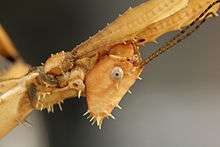
All phasmids possess compound eyes, but ocelli (light-sensitive organs) are only found in some winged males.[4] Phasmids have an impressive visual system that allows them to perceive significant detail even in dim conditions, which suits their typically nocturnal lifestyle. They are born equipped with tiny compound eyes with a limited number of facets. As phasmids grow through successive molts, the number of facets in each eye is increased along with the number of photoreceptor cells. The sensitivity of the adult eye is at least tenfold that of the nymph in its first instar (developmental stage). As the eye grows more complex, the mechanisms to adapt to dark/light changes are also enhanced: eyes in dark conditions evidence fewer screening pigments, which would block light, than during the daytime, and changes in the width of the retinal layer to adapt to changes in available light are significantly more pronounced in adults. The larger size of the adult insects' eyes makes them more prone to radiation damage. This explains why fully grown individuals are mostly nocturnal. Lessened sensitivity to light in the newly emerged insects helps them to escape from the leaf litter wherein they are hatched and move upward into the more brightly illuminated foliage. Young stick insects are diurnal (daytime) feeders and move around freely, expanding their foraging range.[5]
Stick insects have two types of pads on their legs: sticky "toe pads" and non-stick "heel pads" a little further up their legs. The heel pads are covered in microscopic hairs which create strong friction at low pressure, enabling them to grip without having to be peeled energetically from the surface at each step. The sticky toe pads are used to provide additional grip when climbing but are not used on a level surface.[6]
Distribution
Phasmatodea can be found all over the world except for the Antarctic and Patagonia. They are most numerous in the tropics and subtropics. The greatest diversity is found in Southeast Asia and South America, followed by Australia, Central America, and the southern United States.[7] Over 300 species are known from the island of Borneo, making it the richest place in the world for Phasmatodea.[8]
Antipredator adaptations
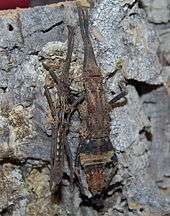
Phasmatodea species exhibit mechanisms for defense from predators that prevent an attack from happening in the first place (primary defense), and defenses that are deployed after an attack has been initiated (secondary defense).[9]
The defense mechanism most readily identifiable with Phasmatodea is camouflage, in the form of a plant mimicry. Most phasmids are known for effectively replicating the forms of sticks and leaves, and the bodies of some species (such as Pseudodiacantha macklotti and Bactrododema centaurum) are covered in mossy or lichenous outgrowths that supplement their disguise. Remaining absolutely stationary enhances their inconspicuousness.[9] Some species have the ability to change color as their surroundings shift (Bostra scabrinota, Timema californica). In a further behavioral adaptation to supplement crypsis, a number of species perform a rocking motion where the body is swayed from side to side; this is thought to mimic the movement of leaves or twigs swaying in the breeze.[10][11] Another method by which stick insects avoid predation and resemble twigs is by entering a cataleptic state, where the insect adopts a rigid, motionless posture that can be maintained for a long period.[12] The nocturnal feeding habits of adults also help Phasmatodea to remain concealed from predators.[12]
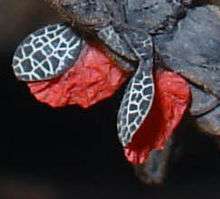
In a seemingly opposite method of defense, many species of Phasmatodea, seek to startle the encroaching predator by flashing bright colors that are normally hidden, and making a loud noise.[13] When disturbed on a branch or foliage, some species, while dropping to the undergrowth to escape, will open their wings momentarily during free fall to display bright colors that disappear when the insect lands. Others will maintain their display for up to 20 minutes, hoping to frighten the predator and convey the appearance of a larger size. Some, such as Pterinoxylus spinulosus, accompany the visual display with the noise made by rubbing together parts of the wings.[13]
Some species, such as the young nymphs of Extatosoma tiaratum, have been observed to curl the abdomen upwards over the body and head to resemble ants or scorpions in an act of mimicry, another defense mechanism by which the insects avoid becoming prey. The eggs of some species such as Diapheromera femorata have fleshy projections resembling elaiosomes (fleshy structures sometimes attached to seeds) that attract ants. When the egg has been carried to the colony, the adult ant feeds the elaiosome to a larva while the phasmid egg is left to develop in the recesses of the nest in a protected environment.[14]
When threatened, some phasmids that are equipped with femoral spines on the metathoracic legs (Oncotophasma martini, Eurycantha calcarata, Eurycantha horrida, Diapheromera veliei, Diapheromera covilleae) respond by curling the abdomen upward and repeatedly swinging the legs together, grasping at the threat. If the menace is caught, the spines can, in humans, draw blood and inflict considerable pain.[10]
Some species are equipped with a pair of glands at the anterior (front) edge of the prothorax that enables the insect to release defensive secretions, including chemical compounds of varying effect: some produce distinct odors, and others can cause a stinging, burning sensation in the eyes and mouth of a predator.[15] The spray often contains pungent-smelling volatile metabolites, previously thought to be concentrated in the insect from its plant food sources. However, it now seems more likely that the insect manufactures its own defensive chemicals.[16] Additionally, the chemistry of the defense spray from at least one species, Anisomorpha buprestoides, has been shown to vary[16] based on the insect's life stage or the particular population it is part of.[17] This chemical spray variation also corresponds with regionally specific color forms in populations in Florida, with the different variants having distinct behaviors.[18] The spray from one species, Megacrania nigrosulfurea, is used as a treatment for skin infections by a tribe in Papua New Guinea because of its antibacterial constituents.[19] Some species employ a shorter-range defensive secretion, where individuals bleed reflexively through the joints of their legs and the seams of the exoskeleton when bothered, allowing the blood (hemolymph), which contains distasteful compounds, to discourage predators. Another ploy is to regurgitate their stomach contents when harassed, repelling potential predators.[20]
Life cycle
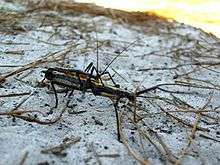
The life cycle of the stick insect begins when the female deposits her eggs through one of these methods of oviposition: she will either flick her egg to the ground by a movement of the ovipositor or her entire abdomen, carefully place the eggs in the axils of the host plant, bury them in small pits in the soil, or stick the eggs to a substrate, usually a stem or leaf of the food plant. A single female lays from 100 to 1,200 eggs after mating, depending on the species.[10]
Many species of phasmids are parthenogenic, meaning the females lay eggs without needing to mate with males to produce offspring. Eggs from virgin mothers are entirely female and hatch into nymphs that are exact copies of their mothers. Stick insect species that are the product of hybridisation are usually obligate parthenogens,[21] but non-hybrids are facultative parthenogens, meaning they retain the ability to mate and their sexual behavior depends on the presence and abundance of males.[22]
Phasmatodea eggs resemble seeds in shape and size and have hard shells. They have a lid-like structure called an operculum at the anterior pole, from which the nymph emerges during hatching. The eggs vary in the length of time before they hatch which varies from 13 to more than 70 days, with the average around 20 to 30 days.[10] Some species, particularly those from temperate regions, undergo diapause, where development is delayed during the winter months. Diapause is initiated by the effect of short day lengths on the egg-laying adults or can be genetically determined. Diapause is broken by exposure to the cold of winter, causing the eggs to hatch during the following spring. Among species of economic importance such as Diapheromera femorata, diapause results in the development of two-year cycles of outbreaks.[23]

Many species' eggs bear a fatty, knoblike capitulum that caps the operculum. This structure attracts ants because of its resemblance to the elaiosome of some plant seeds that are sought-after food sources for ant larvae, and usually contribute to ensuring seed dispersal by ants, a form of ant-plant mutualism called myrmecochory. The ants take the egg into their nest underground and can remove the capitulum to feed to their larvae without harming the phasmid embryo. There, the egg hatches and the young nymph, which initially resembles an ant (another instance of mimicry among Phasmatodea), eventually emerges from the nest and climbs the nearest tree to safety in the foliage.[10] The eggs of stick insects have a coating of calcium oxalate which makes them survive unscathed in the digestive tract of birds. It has been suggested that birds may have a role in the dispersal of parthenogenetic stick insect species, especially to islands.[24]
The Phasmatodea life cycle is hemimetabolous, proceeding through a series of several nymphal instars. Once emerged, a nymph will eat its cast skin. Adulthood is reached for most species after several months and many molts. The lifespan of Phasmatodea varies by species, but ranges from a few months to up to three years.[25]
Ecology
Phasmids are herbivorous, feeding mostly on the leaves of trees and shrubs, and a conspicuous component of many neotropical (South American) systems. Phasmatodea has been postulated as dominant light-gap herbivores there. Their role in the forest ecosystem is considered important by many scientists, who stress the significance of light gaps in maintaining succession and resilience in climax forests. The presence of phasmids lowers the net production of early successional plants by consuming them and then enriches the soil by defecation. This enables the late succession plants to become established and encourages the recycling of the tropical forest.[26]
Phasmatodea are recognized as injurious to forest and shade trees by defoliation. Didymuria violescens, Podacanthus wilkinsoni and Ctenomorphodes tessulatus in Australia, Diapheromera femorata in North America and Graeffea crouani in coconut plantations in the South Pacific all occur in outbreaks of economic importance.[27] Indeed, in the American South, as well as in Michigan and Wisconsin, the walking stick is a significant problem in parks and recreation sites, where it consumes the foliage of oaks and other hardwoods. Severe outbreaks of the walking stick, Diapheromera femorata, have occurred in the Ouachita Mountains of Arkansas and Oklahoma. The insects eat the entire leaf blade. In the event of heavy outbreaks, entire stands of trees can be completely denuded.[28] Continuous defoliation over several years often results in the death of the tree. Because these species cannot fly, infestations are typically contained to a radius of a few hundred yards. Nevertheless, the damage incurred to parks in the region is often costly. Control efforts in the case of infestations have typically involved chemical pesticides; ground fires are effective at killing eggs but have obvious disadvantages.[28] In New South Wales, research has investigated the feasibility of controlling stick insects using natural enemies such as parasitic wasps (Myrmecomimesis spp.).[29]
Taxonomy
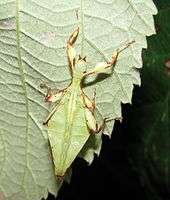
The classification of the Phasmatodea is complex and the relationships between its members are poorly understood.[30] Furthermore, there is much confusion over the ordinal name. Phasmida is preferred by many authors, though it is incorrectly formed; Phasmatodea is correctly formed, and is widely accepted.[31] However, Brock and Marshall argue:[32]
Phasmida is the oldest and simplest name, first used by Leach in 1815 in "Brewster’s Edinburgh Encyclopaedia" volume 9, p.119, and widely used in major entomological textbooks, dictionaries and many scientific papers and books on phasmids. As there is no compulsion to select the "grammatically correct" name [which some argue is Phasmatodea Jacobson & Bianchi, 1902], selection of a long established (and simple) name is reasonable, although the probability of persuading all colleagues to agree on the use of Phasmida is unlikely.
The order Phasmatodea is sometimes considered to be related to other orders, including the Blattodea, Mantodea, Notoptera and Dermaptera, but the affiliations are uncertain and the grouping (sometimes referred to as "Orthopteroidea") may be paraphyletic (not have a common ancestor) and hence invalid in the traditional circumscription (set of attributes that all members have). Phasmatodea, once considered a suborder of Orthoptera, is now treated as an order of its own.[33] Anatomical features separate them as a monophyletic (descended from a common ancestor) group from the Orthoptera. One is the instance among all species of Phasmatodea of a pair of exocrine glands inside the prothorax used for defense. Another is the presence of a specially formed sclerite (hardened plate), called a vomer, which allows the male to clasp the female during mating.[34]
The order is divided into two, or sometimes three, suborders.[34] The most common division is into the suborder groups Anareolatae and Areolatae, which are distinguished according to whether the insect has sunken areola, or circular areas, on the underside of the apices of the middle and hind tibiae (Areolate) or not (Anareolate). However the phylogenetic (evolutionary) relationships between the different groups is poorly resolved. The monophyly of Anareolatae has been questioned and the morphology of the eggs may be a better basis for classification.[31] An alternative is to divide the Phasmatodea into three suborders Agathemerodea (1 genus and 8 species), Timematodea (1 genus and 21 species) and Verophasmatodea for the remaining taxa.[35] This division is, however, not fully supported by the molecular studies, which recover Agathemerodea as nested within Verophasmatodea rather than being the sister group of the latter group.[36][37] Over 3,000 species have been described, with many more yet to be described both in museum collections and in the wild.[38]
Phasmatodea fossils are rare, whether as adults or as eggs; isolated wings are the parts most commonly found. The modern group is monophyletic. Several Mesozoic families appear to be related to the phasmids, and are generally but not universally agreed to be stem group stick insects. One species is known (as a forewing) from the productive Crato Formation fossil beds of Brazil, Cretophasma araripensis (Aerophasmatidae). Other members of the Aerophasmatidae are known from the Jurassic of England, Germany and Kazakhstan.[39] Phasmids are rare in amber, but Gallophasma longipalpis was found in 2010 in the Early Eocene of France.[40] Engel, Wang and Alqarni (2016) described a member of the family Phasmatidae sensu lato from the Cretaceous (Cenomanian) Burmese amber, Echinosomiscus primoticus. According to the authors, the discovery of E. primoticus provides the first reliable evidence for Euphasmatodea (the clade containing all living phasmatodeans except members of the genus Timema) and even Neophasmatodea (the clade containing all living members of Euphasmatodea except aschiphasmatids) in the Cenomanian.[41] Many extinct stem-Phasmatids belong to the superfamily Susumanioidea which contains 22 genera dating from the Jurassic to Eocene, including Eoprephasma and Cretophasmomima.
The earliest leaf insect (Phylliinae) fossil is Eophyllium messelensis from the 47-million-year-old Eocene of Messel, Germany. In size and cryptic (leaflike) body form, it closely resembles extant species, suggesting that the behavior of the group has changed little since that time.[42]
| Suborders | No. of Species | Defining Notes | Image |
|---|---|---|---|
| Agathemerodea | 8 | More information needed | .jpg) |
| Timema | 21 | Considered earliest to branch from phylogenetic tree |  |
| Verophasmatodea | Unknown | Vast majority of extant species | Need specific image |
Notable species
One Australian species, the Lord Howe Island stick insect, is now listed as critically endangered. It was believed extinct until its rediscovery on the rock known as Ball's Pyramid.[45] An effort is underway in Australia to rear this species in captivity.
The best known of the stick insects is the Indian or laboratory stick insect (Carausius morosus). This insect grows to roughly 10 cm (4 in) and reproduces parthenogenically, and although males have been recorded, they are rare.[46]
Fossils of the extinct genus and species Eoprephasma hichensi have been recovered from Ypresian age sediments in the U.S. state of Washington and British Columbia, Canada. The species is one of the youngest members of the stem phasmatodean group Susumanioidea.[47]
Phasmids in Europe
In Europe there are 17 species of stick insects described, belonging to the genera Bacillus Clonopsis, Leptynia and Pijnackeria. There are also a few other species that live in Europe but are introduced, as for example with a couple of species of Acanthoxyla, which are native to New Zealand but are present in southern England.
In the Iberian Peninsula there are currently described 13 species and several subspecies. Their life cycle is annual, living only during the hottest months (especially genera Leptynia and Pijnackeria), which usually means late spring to early autumn.
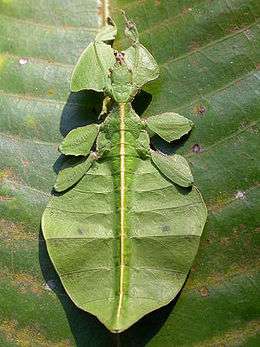 Phyllium sp., from the Western Ghats.
Phyllium sp., from the Western Ghats.
 Ctenomorpha chronus.
Ctenomorpha chronus. Leptynia hispanica
Leptynia hispanica
Behavior
Stick insects, like praying mantises, show rocking behavior in which the insect makes rhythmic, repetitive, side-to-side movements. The common interpretation of this behavior's function is it enhances crypsis by mimicking vegetation moving in the wind. These movements may also be important in allowing the insects to discriminate objects from the background by relative motion. Rocking movements by these generally sedentary insects may replace flying or running as a source of relative motion to help them discern objects in the foreground.[48]
Mating behavior in Phasmatodea is impressive because of the extraordinarily long duration of some pairings. A record among insects, the stick insect Necroscia sparaxes, found in India, is sometimes coupled for 79 days at a time. It is not uncommon for this species to assume the mating posture for days or weeks on end, and among some species (Diapheromera veliei and D. covilleae), pairing can last three to 136 hours in captivity.[49]
Overt displays of aggression between males over mates suggests that extended pairing may have evolved to guard females from sperm competition. Fighting between competing males has been observed in the species D. veiliei and D. covilleae.[50] During these encounters, the approach of a challenger causes the existing mate to manipulate the female's abdomen, which he has clasped by means of the clasping organ, or vomer, down upon itself to block the site of attachment. Occasionally, the consort will strike out at the competitor with the mid femora, which are equipped with an enlarged and hooked spine in both sexes that can draw the blood of the opponent when they are flexed against the body to puncture the integument.[50] Usually, a strong hold on the female's abdomen and blows to the intruder are enough to deter the unwanted competition, but occasionally the competitor has been observed to employ a sneaky tactic to inseminate the female. While the first mate is engaged in feeding and is forced to vacate the dorsal position, the intruder can clasp the female's abdomen and insert his genitalia. If he is discovered, the males will enter into combat wherein they lean backward, both clasped to the female's abdomen, and freely suspended, engage in rapid, sweeping blows with their forelegs in a manner similar to boxing. Usually, when the intruder gains attachment to the female's abdomen, these conflicts result in the displacement of the original mate.[50]
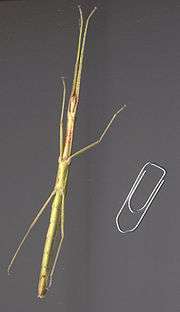
Lengthy pairings have also been described in terms of a defensive alliance. When cleaved together, the pair is more unwieldy for predators to handle. Also, the chemical defenses (secretions, reflex bleeding, regurgitation) of the individual stick insect are enhanced when two are paired. Females survive attacks by predators significantly better when pairing, largely because the dorsal position of the male functions well as a shield. This could indicate that manipulation by females is taking place: if females accept ejaculate at a slow rate, for instance, the males are forced to remain in copulo for longer and the female's chances of survival are enhanced. Also, evolution could have simply favored males that remained attached to their females longer, since females are often less abundant than males and represent a valuable prize, so for the lucky male, even the sacrifice of his own life to preserve his offspring with the female may be worthwhile. Sexual dimorphism in the species, where females are usually significantly larger than the males, may have evolved due to the fitness advantage accrued to males that can remain attached to the female, thereby blocking competitors, without severely impeding her movement.[49]
Certain Phasmatodea, such as Anisomorpha buprestoides, sometimes form aggregations. These insects have been observed to congregate during the day in a concealed location, going their separate ways at nightfall to forage, and returning to their refuge before dawn. Such behavior has been little studied, and how the insects find their way back is unknown.[20]
In human culture
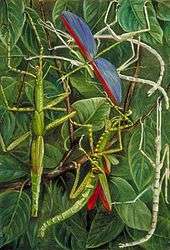
Stick insects are often kept in captivity: almost 300 species have been reared in laboratories or as pets.[51] The most commonly kept is the Indian (or laboratory) stick insect, Carausius morosus, which eats vegetables such as lettuce.[52] Droppings of the stick insect Eurycnema versirubra (Serville, 1838) [=Eurycnema versifasciata] fed with specific plants are made into a medicinal tea by Malaysian Chinese to treat ailments.[53]
The botanical illustrator Marianne North (1830–1890) painted leaf and stick insects that she saw on her travels in the 1870s.[54]
Tribesmen in Sarawak eat phasmids and their eggs.[55]
Some indigenous people of the D'Entrecasteaux Islands have traditionally made fishhooks from the legs of certain phasmids.[56]
Research has been conducted to analyze the stick insect method of walking and apply this to the engineering of six-legged walking robots. Instead of one centralized control system, it seems each leg of a phasmid operates independently.[57]
In Australia and Hawaii many kinds of stick insects are kept as exotic pets including the Strong, Goliath, Spiny and Children's. The custom of keeping stick insects as pets was probably brought to Australia by either Chinese, Japanese or Vietnamese immigrants during the World War II, Korean Wars or Vietnamese War.
Stick insects have been kept as pets since the time of the Han dynasty. They were kept inside birdcages and people in the Far East believe they bring good luck and fortune, just like crickets.[58]
References
- "Spectra Latreille 1802". Nomina circumscribentia insectorum. Retrieved 21 June 2020.
- "Phobaeticus chani: Chan's megastick". Picture library. Natural History Museum. Archived from the original on 5 March 2016. Retrieved 28 October 2015.
- "Phasmids: An Introduction to the Stick Insects and Leaf Insects". Retrieved 22 March 2011.
- Hoell, H.V.; Doyen, J.T.; Purcell, A.H. (1998). Introduction to Insect Biology and Diversity (2nd ed.). Oxford University Press. pp. 398–399. ISBN 978-0-19-510033-4.
- Meyer-Rochow, V. Benno; Essi Keskinen (2003). "Post-embryonic photoreceptor development and dark/light adaptation in the stick insect Carausius morosus (Phasmida, Phasmatidae)". Applied Entomology and Zoology. 38 (3): 281–291. doi:10.1303/aez.2003.281.
- "How stick insects honed friction to grip without sticking". Phys.org. 19 February 2014. Retrieved 3 October 2015.
- "Distribution for order Phasmida". Retrieved 2 October 2015.
- Bragg, Philip E. (2001). Phasmids of Borneo. Kota Kinabalu. ISBN 978-983-812-027-2.
- Matthews, Robert W.; Matthews, Janice R. (2009). Insect Behavior. Springer Science & Business Media. pp. 187–189. ISBN 978-90-481-2389-6.
- Bedford, Geoffrey O. (1978). "Biology and Ecology of the Phasmatodea". Annual Review of Entomology. 23: 125–149. doi:10.1146/annurev.en.23.010178.001013.
- Bian, Xue; Elgar, Mark A.; Peters, Richard A. (1 January 2016). "The swaying behavior of Extatosoma tiaratum: motion camouflage in a stick insect?". Behavioral Ecology. 27 (1): 83–92. doi:10.1093/beheco/arv125. ISSN 1045-2249.
- Robinson, Michael H. (1968). "The defensive behaviour of the Javanese stick insect, Orxines macklotti De Haan, with a note on the startle display of Metriotes diocles (Westw.)(Phasmatodea, Phasmidae)". Entomologist's Monthly Magazine. 104: 46–54.
- Robinson, Michael H. (1968). "The defensive behavior of Pterinoxylus spinulosus Redtenbacher, a winged stick insect from Panama (Phasmatodea)". Psyche. 75 (3): 195–207. doi:10.1155/1968/19150.
- Harrington, Lindsay; Sannino, Dave (2011). "Diapheromera femorata: Common American Walkingstick". Animal Diversity Web. University of Michigan. Retrieved 7 October 2015.
- Dossey, Aaron (December 2010). "Insects and their chemical weaponry: New potential for drug discovery". Natural Product Reports. 27 (12): 1737–1757. doi:10.1039/C005319H. PMID 20957283.
- Dossey, Aaron; Spencer Walse; James R. Rocca; Arthur S. Edison (September 2006). "Single-Insect NMR: A New Tool To Probe Chemical Biodiversity". ACS Chemical Biology. 1 (8): 511–514. doi:10.1021/cb600318u. PMID 17168538.
- Dossey, Aaron; Spencer S. Walse; Arthur S. Edison (2008). "Developmental and Geographical Variation in the Chemical Defense of the Walkingstick Insect Anisomorpha buprestoides". Journal of Chemical Ecology. 34 (5): 584–590. doi:10.1007/s10886-008-9457-8. PMID 18401661.
- Conle, Oskar; Frank H. Hennemann; Aaron T. Dossey (March 2009). "Survey of the Color Forms of the Southern Twostriped Walkingstick (Phasmatodea: Areolatae: Pseudophasmatidae: Pseudophasmatinae: Anisomorphini), With Notes on Its Range, Habitats, and Behaviors". Annals of the Entomological Society of America. 102 (2): 210–232. doi:10.1603/008.102.0204.
- Prescott, T.; Bramham, J.; Zompro, O.; Maciver, S.K. (2010). "Actinidine and glucose from the defensive secretion of the stick insect Megacrania nigrosulfurea". Biochemical Systematics and Ecology. 37 (6): 759–760. doi:10.1016/j.bse.2009.11.002.
- Costa, James T. (2006). The Other Insect Societies. Harvard University Press. pp. 141–144. ISBN 978-0-674-02163-1.
- Morgan-Richards, M.; Trewick, S. A. (2005). "Hybrid origin of a parthenogenetic genus?". Molecular Ecology. 14 (7): 2133–2142. doi:10.1111/j.1365-294X.2005.02575.x. PMID 15910332.
- Morgan-Richards, M.; Trewick, S. A.; Stringer, I. N. A. N. (2010). "Geographic parthenogenesis and the common tea-tree stick insect of New Zealand". Molecular Ecology. 19 (6): 1227–1238. doi:10.1111/j.1365-294X.2010.04542.x. PMID 20163549.
- Resh, Vincent H.; Cardé, Ring T. (2009). Encyclopedia of Insects. Academic Press. p. 392. ISBN 978-0-08-092090-0.
- Suetsugu, Kenji; Funaki, Shoichi; Takahashi, Asuka; Ito, Katsura; Yokoyama, Takeshi (29 May 2018). "Potential role of bird predation in the dispersal of otherwise flightless stick insects" (PDF). Ecology. 99 (6): 1504–1506. doi:10.1002/ecy.2230. ISSN 0012-9658. PMID 29809279.
- "Stick Insect: Phasmida". Animals A-Z. National Geographic. Retrieved 10 October 2015.
- Willig, Michael R.; Rosser W. Garrison; Arlene J. Bauman (1986). "Population dynamics and natural history of a neotropical walking stick, Lamponius Portoricensis Rehn (Phasmatodea: Phasmatidae)". The Texas Journal of Science. 38.
- Baker, E. (2015). "The worldwide status of stick insects (Insecta: Phasmida) as pests of agriculture and forestry, with a generalised theory of phasmid outbreaks". Agriculture and Food Security. 4 (22). doi:10.1186/s40066-015-0040-6.
- Craighead, Frank Cooper; Schaffner, John Valentine (1950). Insect Enemies of Eastern Forests. U.S. Government Printing Office. pp. 97–98.
- Campbell, K.G. (1959). "The importance of research into forest insect problems in New South Wales". Australian Forestry. 23 (1): 19–23. doi:10.1080/00049158.1959.10675860.
- "Classification of the Phasmatodea". Phasmatodea.com. Archived from the original on 3 October 2015. Retrieved 2 October 2015.
- Zompro, O. (2004). "Revision of the genera of the Areolatae, including the status of Timema and Agathemera (Insecta: Phasmatodea)". Organización Para Estudios Tropicales, (OET), Costa Rica Bibliografía Nacional en Biología Tropical (BINABITROP). 37: 1–327.
- Brock, Paul D.; Marshall, Judith (2011). "Order Phasmida Leach. 1815." (PDF). In Zhang, Z.-Q. (ed.). Animal biodiversity: An outline of higherlevel classification and survey of taxonomic richness.
- Brock, Paul D. "Phasmida Species File Online. Version 5.0". Retrieved 2 October 2015.
- O'Toole, Christopher. "Leaf and Stick Insects". Oxford University Press.
- Animal biodiversity: An outline of higher-level classification and survey of taxonomic richness. Magnolia Press. 2011. p. 198. ISBN 978-1-86977-849-1.
- Thomas R. Buckley; Dilini Attanayake; Sven Bradler (2009). "Extreme convergence in stick insect evolution: phylogenetic placement of the Lord Howe Island tree lobster". Proceedings of the Royal Society B: Biological Sciences. 276 (1659): 1055–1062. doi:10.1098/rspb.2008.1552. PMC 2679072. PMID 19129110.
- Sven Bradler; James A. Robertson; Michael F. Whiting (2014). "A molecular phylogeny of Phasmatodea with emphasis on Necrosciinae, the most species-rich subfamily of stick insects". Systematic Entomology. 39 (2): 205–222. doi:10.1111/syen.12055.
- Bragg, P.E. (2001) Phasmids of Borneo, Natural History Publications (Borneo), Kota Kinabalu. - see p. 614.
- Martill, David M.; Bechly, Günter; Loveridge, Robert F. (2007). The Crato Fossil Beds of Brazil: Window into an Ancient World. Cambridge University Press. pp. 265–266. ISBN 978-1-139-46776-6.
- Penney, David; Green, David I.; Marusik, Yuri M. (2011). Fossils in Amber: Remarkable Snapshots of Prehistoric Forest Life. Siri Scientific Press. p. 112. ISBN 978-0-9558636-6-0.
- Michael S. Engel, Bo Wang & Abdulaziz S. Alqarni (2016). "A thorny, 'anareolate' stick-insect (Phasmatidae s.l.) in Upper Cretaceous amber from Myanmar, with remarks on diversification times among Phasmatodea". Cretaceous Research. 63: 45–53. doi:10.1016/j.cretres.2016.02.015.
- Wedmann, Sonja; Bradler, Sven; Rust, Jes (2006). "The first fossil leaf insect: 47 million years of specialized cryptic morphology and behavior". PNAS. 104 (2): 565–569. doi:10.1073/pnas.0606937104. PMC 1766425. PMID 17197423.
- "Insect poses prickly questions" on Otago Daily Times website, viewed 2013-10-16
- Brock, Paul (2018). "Missing stickman found: The first male of the parthenogenetic New Zealand Phasmid genus Acanthoxyla Uvarov, 1944 discovered in the United Kingdom". Atropos. 60: 16–23.
- ANZECC Endangered Fauna Network (2002). "Dryococelus australis". IUCN Red List of Threatened Species. 2002. Retrieved 10 October 2015.CS1 maint: ref=harv (link)
- Headrick, D.H.; Walen, C.A. (1 May 2011). "Indian walking stick". Pests in Gardens and Landscapes. UC IPM. Retrieved 10 October 2015.
- Archibald, SB; Bradler, S (2015). "Stem-group stick insects (Phasmatodea) in the early Eocene at McAbee, British Columbia, Canada, and Republic, Washington, United States of America". Canadian Entomologist. 147 (6): 1–10. doi:10.4039/tce.2015.2.
- O'Dea, JD. Eine zusatzliche oder alternative Funktion der 'kryptischen' Schaukelbewegung bei Gottesanbeterinnen und Stabschrecken (Mantodea, Phasmatodea). Entomologische Zeitschrift, 101, Nr. 1/2, 15 Januar 1991, 25-27.
- Sivinski, John (1980). "Effects of Mating on Predation in the Stick Insect Diapheromera veliei Walsh (Phasmatodea: Heteronemiidae)". Annals of the Entomological Society of America. 73 (5): 553–556. doi:10.1093/aesa/73.5.553.
- Sivinski, John (1978). "Intersexual Aggression in the Stick Insects Diapheromera veliei and D. covilleae and Sexual Dimorphism in the Phasmatodea". Psyche. 85 (4): 395–403. doi:10.1155/1978/35784.
- Bragg, P (2008). "Changes to the PSG Culture List". Phasmid Study Group Newsletter. 113: 4–5.
- Boucher, Stephanie; Hirondelle Varady-Szabo (2005). "Effects of different diets on the survival, longevity and growth rate of the Annam stick insect, Medauroidea extradentata (Phasmatodea: Phasmatidae)". Journal of Orthoptera Research (Submitted manuscript). 14: 115–118. doi:10.1665/1082-6467(2005)14[115:eoddot]2.0.co;2.
- Nadchatram, M. (1963). "The winged stick insect, Eurycnema versifasciata Serville (Phasmida, Phasmatidae), with special reference to its life history". Malayan Nature Journal. 17: 33–40.
- North, Marianne. "Leaf-Insects and Stick-Insects". Art UK. Retrieved 2 October 2015.
- Baker, Edward (2015). "The worldwide status of phasmids (Insecta: Phasmida) as pests of agriculture and forestry, with a generalised theory of phasmid outbreaks" (PDF). Agriculture and Food Security. 4. doi:10.1186/s40066-015-0040-6.
- Osmond, Meredith (1998). "Chapter 8: Fishing and Hunting Implements". In Ross, Malcolm; Pawley, Andrew; Osmond, Meredith (eds.). The lexicon of Proto Oceanic vol. 1 Material culture. Canberra: Pacific Linguistics. p. 219. doi:10.15144/PL-C152.211. ISBN 0-85883-507-X. Retrieved 9 February 2020.
- Dean, Jeffery; Kindermann, Thomas; Schmitz, Josef; Schumm, Michael; Cruse, Holk (1999). "Control of Walking in the Stick Insect: From Behavior and Physiology to Modeling". Autonomous Robots. 7 (3): 271–288. doi:10.1023/A:1008980606521.
- "Care of Stick Insects - Australian Museum". australianmuseum.net.au. Retrieved 8 May 2016.
External links
| Wikimedia Commons has media related to Phasmatodea. |
| Wikispecies has information related to Phasmatodea |
